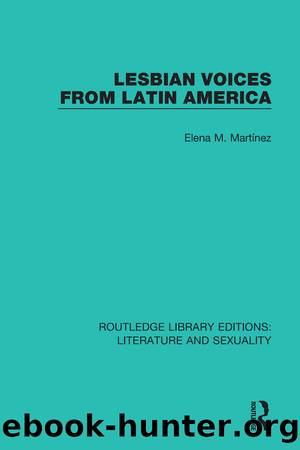Lesbian Voices From Latin America by Elena M. Martínez

Author:Elena M. Martínez [Martínez, Elena M.]
Language: eng
Format: epub
Tags: Social Science, Sociology, General
ISBN: 9781351817899
Google: hkMiEAAAQBAJ
Publisher: Routledge
Published: 2017-10-06T03:30:03+00:00
The question of identity and selfhood is at the center of the mother-daughter dyad. In Electra/Clitemnestra Electraâs selfhood has been defined negatively as separateness from her mother.20 Competition between the mother and the daughter prevails, but it is interesting to note that sexual desire is presented: âPero son dos mujeres encerradas en una historia de/espasmos/odios del útero/entre fauces y cuernos,/hambre de tocarse./Sólo hay llanto/y amargas luchas por quién es quiénâ (29) (But two women are imprisoned in a history of spasms/Uterine hatreds/Between jaws and horns/hungry to touch./There is only weeping/and bitter battles for who is who). In this poem the rivalry between the two women is presented through the juxtaposition of two lines: âLa destrucción de una/traerÃa la redención de la otra/La magnitud de una reside en el aborto de la hija/La madre traga a la hija/La hija en turno aniquila a la madreâ (29) (Destruction of one/would be the otherâs redemption./Grandeur of one demands death for the daughter/Mother swallows the daughter/Daughter in turn annihilates mother). Thus, in Electra/Clitemnestra the representation of the mother-daughter relationship follows the Freudian paradigm in which the selfhood of the daughter depends upon separation from the mother, while both struggle for power and the reaffirmation of self-identity. However, Alabauâs reading detaches itself from traditional interpretation as mother and daughter are united by sexual desire. Here, the representation of the sexual desire between mother and daughter occurs through violent actions. The killing of the mother is an act of vengeance by a daughter deprived of love and nurturance. Throughout the collection the daughter symbolically reclaims nurturance and support, but Clytemnestra does not respond to her daughterâs needs. In poem XI, âEl dolor,â Electra says: âClytemnestra, me muero./Ven, ahuyenta el miedoâ (25) (Clytemnestra, I am dying./Come, chase away fear). And at the end: âEn su cuarto la madre escucha/muda está/no se acercaâ (25) (In her room the mother hears, is mute,/does not come near her).
Culture and tradition have assigned women diametrically opposed identities of being either a bad woman or a good woman.21 The first has been represented as a temptress and a ruthless destroyer such as Medusa; the second as the mother, the source of life. Alabau subverts this view by presenting Clytemnestra not as a nurturing figure but as an unaffectionate mother, a woman interested in sexual satisfaction. Through the representation of Clytemnestra, Alabau confronts the masculine construction of the Great Mother archetype that reinforces and justifies womenâs exclusion from culture. Rosario Castellanos, Simone de Beauvoir, and Adrienne Rich have pointed out that maternity itself, as a natural phenomenon, confers no power on women. In spite of the fact that the mother is respected in her role, she is also subjugated through the institution of motherhood. In the archetype construct, the mother serves the husband in exchange for protection and support within three institutions: virginity, marriage, and the family. These institutions deny women access to sexual pleasure while objectifying them.
In Electra/Clytemnestra, the mother-daughter relationship, central to the notion of female as well as lesbian identity, is emphasized.
Download
This site does not store any files on its server. We only index and link to content provided by other sites. Please contact the content providers to delete copyright contents if any and email us, we'll remove relevant links or contents immediately.
Cecilia; Or, Memoirs of an Heiress — Volume 1 by Fanny Burney(32439)
Cecilia; Or, Memoirs of an Heiress — Volume 2 by Fanny Burney(31875)
Cecilia; Or, Memoirs of an Heiress — Volume 3 by Fanny Burney(31858)
The Great Music City by Andrea Baker(31531)
We're Going to Need More Wine by Gabrielle Union(18973)
All the Missing Girls by Megan Miranda(15595)
Pimp by Iceberg Slim(14399)
Bombshells: Glamour Girls of a Lifetime by Sullivan Steve(13979)
Talking to Strangers by Malcolm Gladwell(13233)
Norse Mythology by Gaiman Neil(13215)
Fifty Shades Freed by E L James(13163)
For the Love of Europe by Rick Steves(13103)
Mindhunter: Inside the FBI's Elite Serial Crime Unit by John E. Douglas & Mark Olshaker(9209)
Crazy Rich Asians by Kevin Kwan(9172)
The Lost Art of Listening by Michael P. Nichols(7412)
Enlightenment Now: The Case for Reason, Science, Humanism, and Progress by Steven Pinker(7242)
The Four Agreements by Don Miguel Ruiz(6639)
Bad Blood by John Carreyrou(6558)
Weapons of Math Destruction by Cathy O'Neil(6152)
